Reflective Competency Assignment: Analysis of Nursing Incident Report
VerifiedAdded on 2020/05/11
|6
|840
|59
Report
AI Summary
This report is a reflective competency assignment completed by a nursing student, focusing on a clinical incident and applying Gibbs' reflective cycle. The assignment details an experience where the student, an enrolled nurse, observed a doctor failing to adhere to proper hand hygiene protocols before examining a patient post-surgery. The report outlines the student's feelings of shock and intimidation, the evaluation of the incident, and the subsequent analysis of the importance of hygiene in preventing infections. The conclusion emphasizes the need for assertive communication and a proactive approach to ensure patient safety, along with an action plan for developing assertive skills. The report highlights the significance of maintaining nursing standards and the importance of reflective practice in improving clinical practice. The assignment includes references to support the reflection.
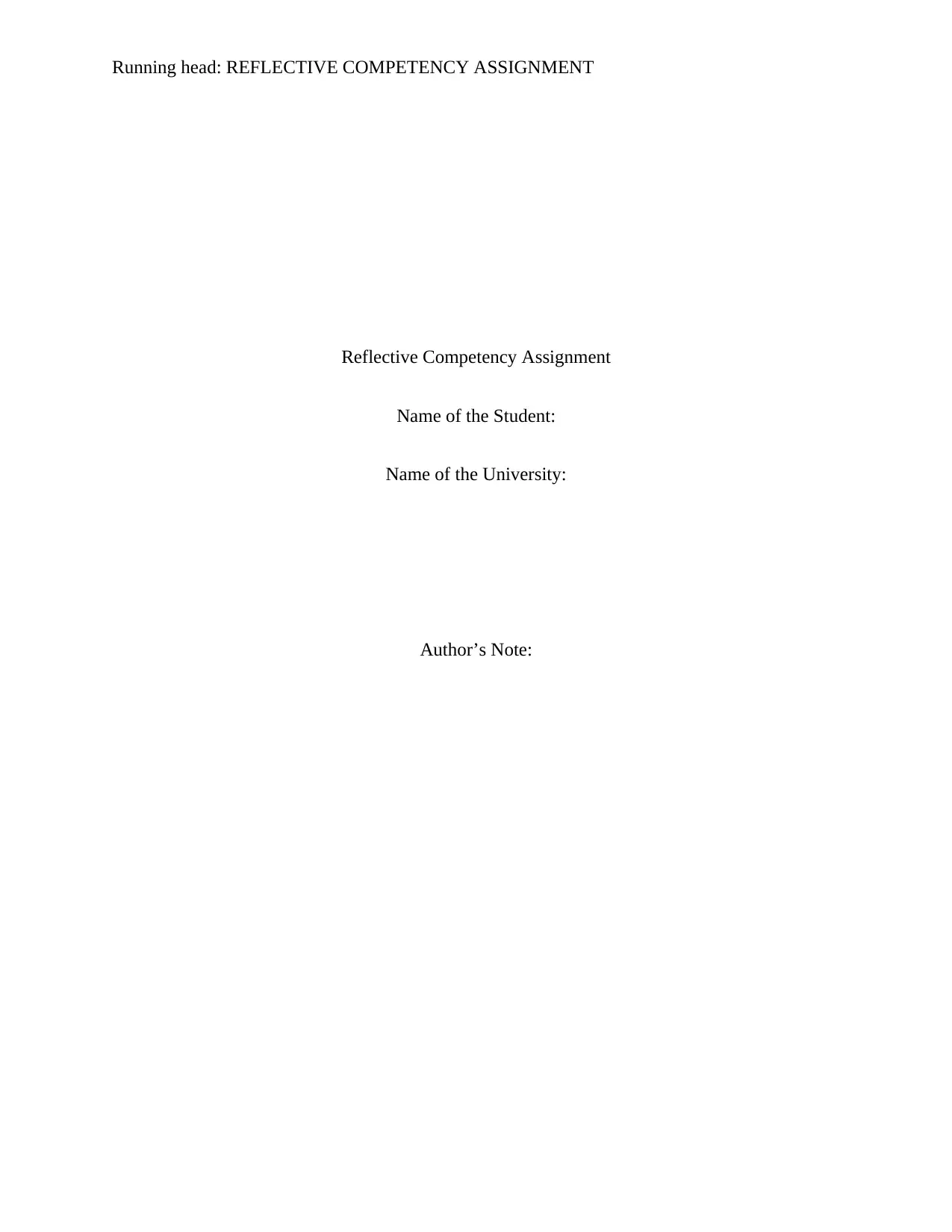
Running head: REFLECTIVE COMPETENCY ASSIGNMENT
Reflective Competency Assignment
Name of the Student:
Name of the University:
Author’s Note:
Reflective Competency Assignment
Name of the Student:
Name of the University:
Author’s Note:
Paraphrase This Document
Need a fresh take? Get an instant paraphrase of this document with our AI Paraphraser
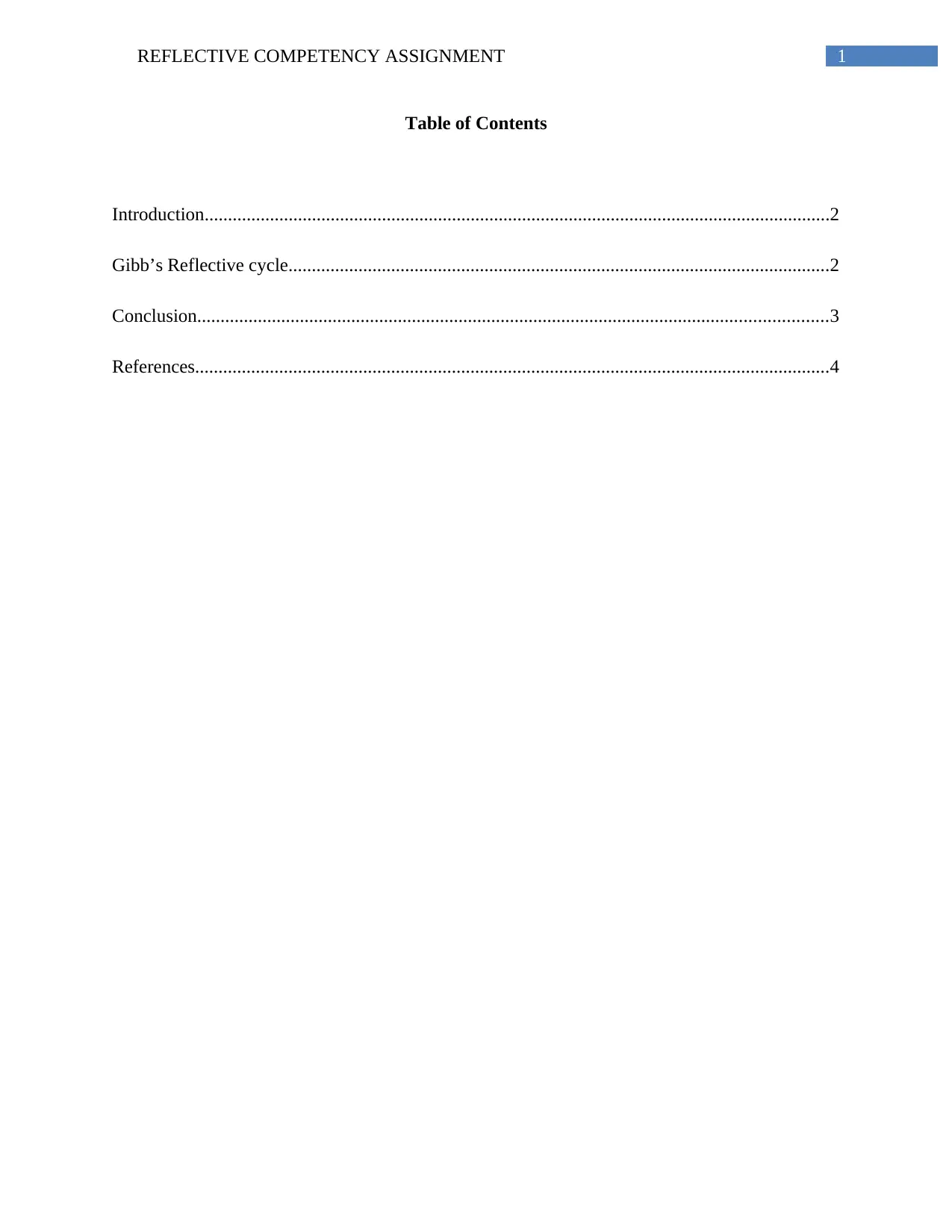
1REFLECTIVE COMPETENCY ASSIGNMENT
Table of Contents
Introduction......................................................................................................................................2
Gibb’s Reflective cycle....................................................................................................................2
Conclusion.......................................................................................................................................3
References........................................................................................................................................4
Table of Contents
Introduction......................................................................................................................................2
Gibb’s Reflective cycle....................................................................................................................2
Conclusion.......................................................................................................................................3
References........................................................................................................................................4
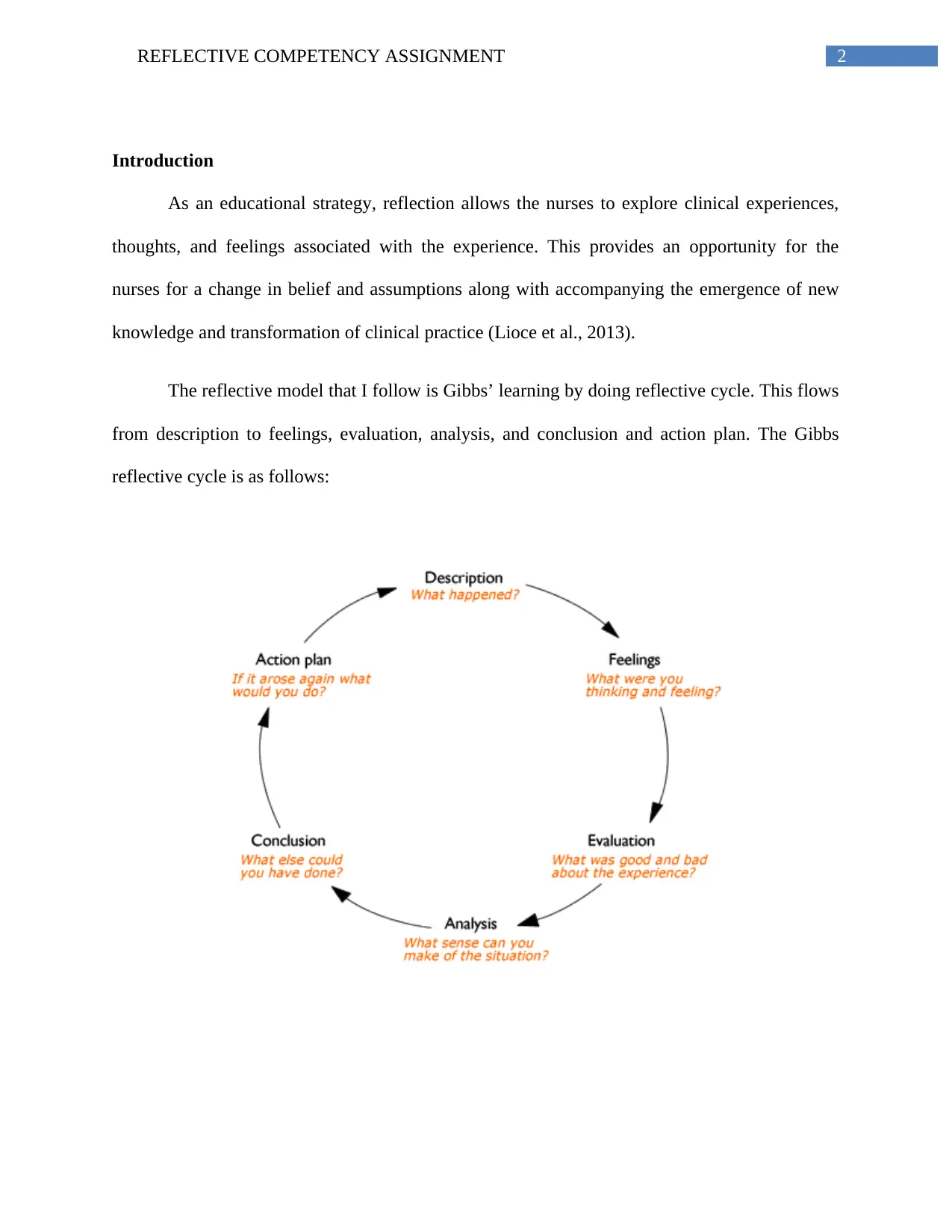
2REFLECTIVE COMPETENCY ASSIGNMENT
Introduction
As an educational strategy, reflection allows the nurses to explore clinical experiences,
thoughts, and feelings associated with the experience. This provides an opportunity for the
nurses for a change in belief and assumptions along with accompanying the emergence of new
knowledge and transformation of clinical practice (Lioce et al., 2013).
The reflective model that I follow is Gibbs’ learning by doing reflective cycle. This flows
from description to feelings, evaluation, analysis, and conclusion and action plan. The Gibbs
reflective cycle is as follows:
Introduction
As an educational strategy, reflection allows the nurses to explore clinical experiences,
thoughts, and feelings associated with the experience. This provides an opportunity for the
nurses for a change in belief and assumptions along with accompanying the emergence of new
knowledge and transformation of clinical practice (Lioce et al., 2013).
The reflective model that I follow is Gibbs’ learning by doing reflective cycle. This flows
from description to feelings, evaluation, analysis, and conclusion and action plan. The Gibbs
reflective cycle is as follows:
⊘ This is a preview!⊘
Do you want full access?
Subscribe today to unlock all pages.

Trusted by 1+ million students worldwide
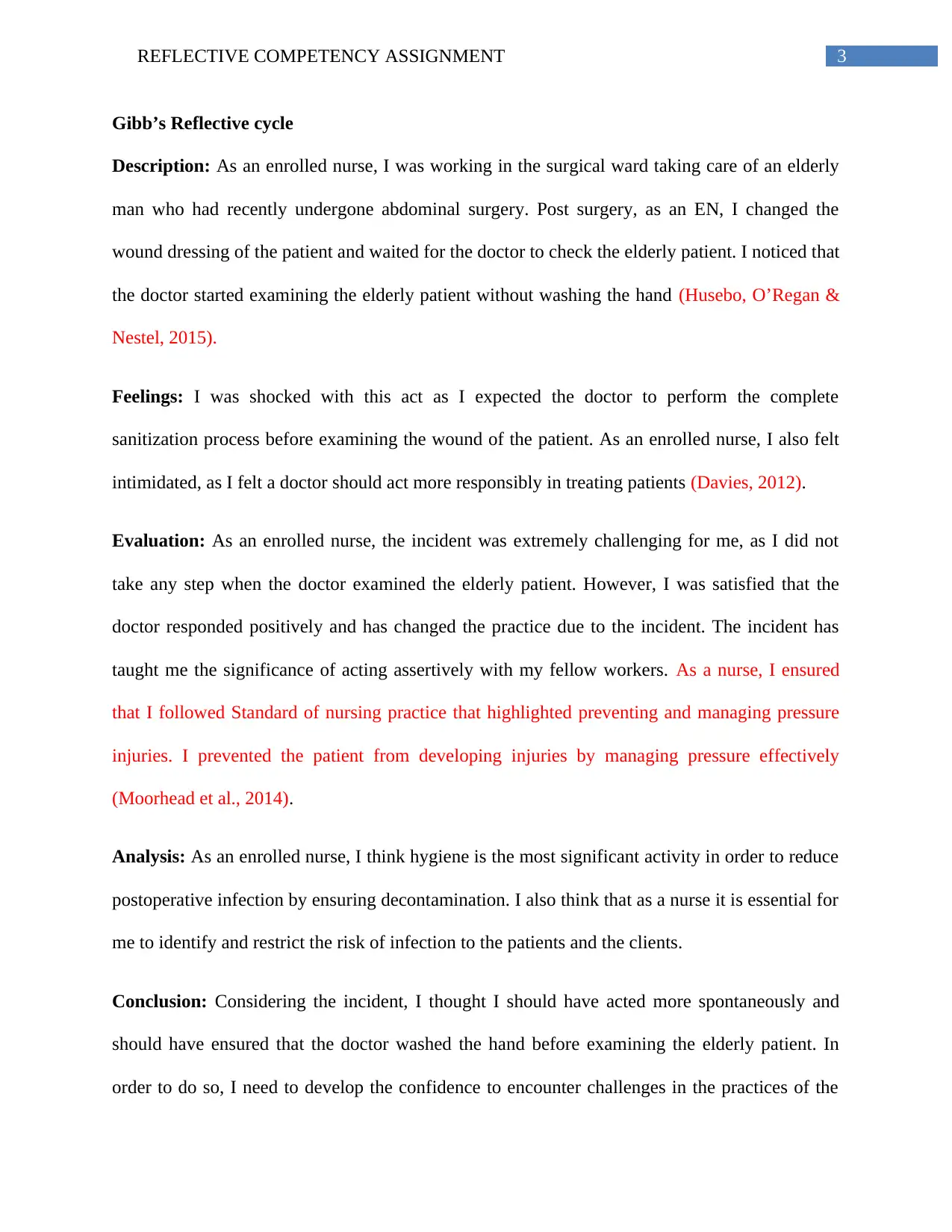
3REFLECTIVE COMPETENCY ASSIGNMENT
Gibb’s Reflective cycle
Description: As an enrolled nurse, I was working in the surgical ward taking care of an elderly
man who had recently undergone abdominal surgery. Post surgery, as an EN, I changed the
wound dressing of the patient and waited for the doctor to check the elderly patient. I noticed that
the doctor started examining the elderly patient without washing the hand (Husebo, O’Regan &
Nestel, 2015).
Feelings: I was shocked with this act as I expected the doctor to perform the complete
sanitization process before examining the wound of the patient. As an enrolled nurse, I also felt
intimidated, as I felt a doctor should act more responsibly in treating patients (Davies, 2012).
Evaluation: As an enrolled nurse, the incident was extremely challenging for me, as I did not
take any step when the doctor examined the elderly patient. However, I was satisfied that the
doctor responded positively and has changed the practice due to the incident. The incident has
taught me the significance of acting assertively with my fellow workers. As a nurse, I ensured
that I followed Standard of nursing practice that highlighted preventing and managing pressure
injuries. I prevented the patient from developing injuries by managing pressure effectively
(Moorhead et al., 2014).
Analysis: As an enrolled nurse, I think hygiene is the most significant activity in order to reduce
postoperative infection by ensuring decontamination. I also think that as a nurse it is essential for
me to identify and restrict the risk of infection to the patients and the clients.
Conclusion: Considering the incident, I thought I should have acted more spontaneously and
should have ensured that the doctor washed the hand before examining the elderly patient. In
order to do so, I need to develop the confidence to encounter challenges in the practices of the
Gibb’s Reflective cycle
Description: As an enrolled nurse, I was working in the surgical ward taking care of an elderly
man who had recently undergone abdominal surgery. Post surgery, as an EN, I changed the
wound dressing of the patient and waited for the doctor to check the elderly patient. I noticed that
the doctor started examining the elderly patient without washing the hand (Husebo, O’Regan &
Nestel, 2015).
Feelings: I was shocked with this act as I expected the doctor to perform the complete
sanitization process before examining the wound of the patient. As an enrolled nurse, I also felt
intimidated, as I felt a doctor should act more responsibly in treating patients (Davies, 2012).
Evaluation: As an enrolled nurse, the incident was extremely challenging for me, as I did not
take any step when the doctor examined the elderly patient. However, I was satisfied that the
doctor responded positively and has changed the practice due to the incident. The incident has
taught me the significance of acting assertively with my fellow workers. As a nurse, I ensured
that I followed Standard of nursing practice that highlighted preventing and managing pressure
injuries. I prevented the patient from developing injuries by managing pressure effectively
(Moorhead et al., 2014).
Analysis: As an enrolled nurse, I think hygiene is the most significant activity in order to reduce
postoperative infection by ensuring decontamination. I also think that as a nurse it is essential for
me to identify and restrict the risk of infection to the patients and the clients.
Conclusion: Considering the incident, I thought I should have acted more spontaneously and
should have ensured that the doctor washed the hand before examining the elderly patient. In
order to do so, I need to develop the confidence to encounter challenges in the practices of the
Paraphrase This Document
Need a fresh take? Get an instant paraphrase of this document with our AI Paraphraser
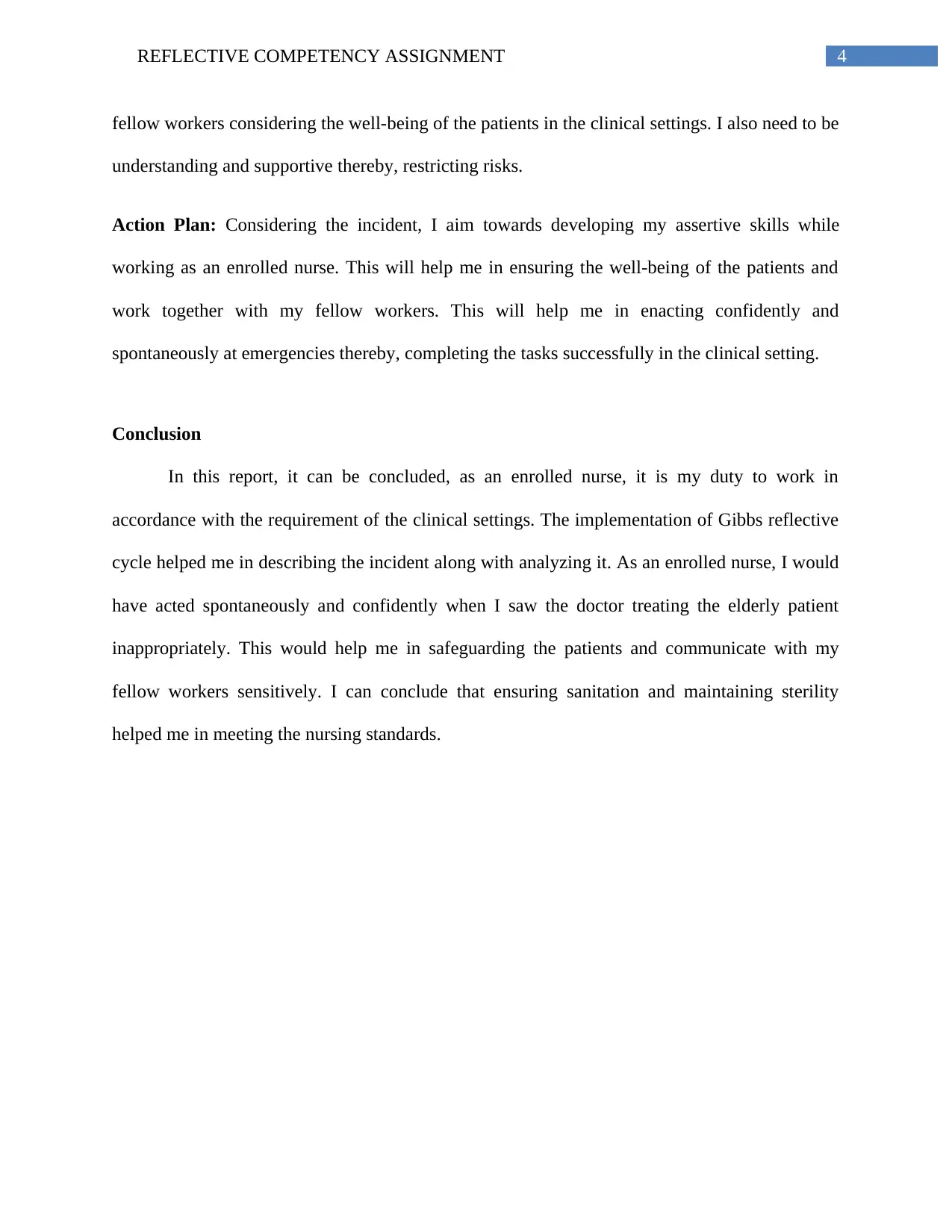
4REFLECTIVE COMPETENCY ASSIGNMENT
fellow workers considering the well-being of the patients in the clinical settings. I also need to be
understanding and supportive thereby, restricting risks.
Action Plan: Considering the incident, I aim towards developing my assertive skills while
working as an enrolled nurse. This will help me in ensuring the well-being of the patients and
work together with my fellow workers. This will help me in enacting confidently and
spontaneously at emergencies thereby, completing the tasks successfully in the clinical setting.
Conclusion
In this report, it can be concluded, as an enrolled nurse, it is my duty to work in
accordance with the requirement of the clinical settings. The implementation of Gibbs reflective
cycle helped me in describing the incident along with analyzing it. As an enrolled nurse, I would
have acted spontaneously and confidently when I saw the doctor treating the elderly patient
inappropriately. This would help me in safeguarding the patients and communicate with my
fellow workers sensitively. I can conclude that ensuring sanitation and maintaining sterility
helped me in meeting the nursing standards.
fellow workers considering the well-being of the patients in the clinical settings. I also need to be
understanding and supportive thereby, restricting risks.
Action Plan: Considering the incident, I aim towards developing my assertive skills while
working as an enrolled nurse. This will help me in ensuring the well-being of the patients and
work together with my fellow workers. This will help me in enacting confidently and
spontaneously at emergencies thereby, completing the tasks successfully in the clinical setting.
Conclusion
In this report, it can be concluded, as an enrolled nurse, it is my duty to work in
accordance with the requirement of the clinical settings. The implementation of Gibbs reflective
cycle helped me in describing the incident along with analyzing it. As an enrolled nurse, I would
have acted spontaneously and confidently when I saw the doctor treating the elderly patient
inappropriately. This would help me in safeguarding the patients and communicate with my
fellow workers sensitively. I can conclude that ensuring sanitation and maintaining sterility
helped me in meeting the nursing standards.

5REFLECTIVE COMPETENCY ASSIGNMENT
References
Davies, S. (2012). Embracing reflective practice. Education for Primary Care, 23(1), 9-12.
Husebø, S. E., O'Regan, S., & Nestel, D. (2015). Reflective practice and its role in simulation.
Clinical Simulation in Nursing, 11(8), 368-375.
Lioce, L., Reed, C. C., Lemon, D., King, M. A., Martinez, P. A., Franklin, A. E., ... & Meakim,
C. (2013). Standards of best practice: Simulation standard III: Participant objectives.
Clinical Simulation in Nursing, 9(6), S15-S18.
Moorhead, S., Johnson, M., Maas, M. L., & Swanson, E. (2014). Nursing Outcomes
Classification (NOC)-E-Book: Measurement of Health Outcomes. Elsevier Health
Sciences.
References
Davies, S. (2012). Embracing reflective practice. Education for Primary Care, 23(1), 9-12.
Husebø, S. E., O'Regan, S., & Nestel, D. (2015). Reflective practice and its role in simulation.
Clinical Simulation in Nursing, 11(8), 368-375.
Lioce, L., Reed, C. C., Lemon, D., King, M. A., Martinez, P. A., Franklin, A. E., ... & Meakim,
C. (2013). Standards of best practice: Simulation standard III: Participant objectives.
Clinical Simulation in Nursing, 9(6), S15-S18.
Moorhead, S., Johnson, M., Maas, M. L., & Swanson, E. (2014). Nursing Outcomes
Classification (NOC)-E-Book: Measurement of Health Outcomes. Elsevier Health
Sciences.
⊘ This is a preview!⊘
Do you want full access?
Subscribe today to unlock all pages.

Trusted by 1+ million students worldwide
1 out of 6
Related Documents
Your All-in-One AI-Powered Toolkit for Academic Success.
+13062052269
info@desklib.com
Available 24*7 on WhatsApp / Email
![[object Object]](/_next/static/media/star-bottom.7253800d.svg)
Unlock your academic potential
Copyright © 2020–2025 A2Z Services. All Rights Reserved. Developed and managed by ZUCOL.





